

DYNAMIC ALLOCATION
WHAT IS DYNAMIC ALLOCATION?
Example program ------> DYNLIST.C
Dynamic allocation is very intimidating to a person the first time he comes across it, but that need not be. Simply relax and read this chapter carefully and you will have a good grounding in a very valuable programming resource. All of the variables in every program up to this point have been static variables as far as we are concerned. (Actually, some of them have been automatic and were dynamically allocated for you by the system, but it was transparent to you.) In this chapter, we will study some dynamically allocated variables. They are variables that do not exist when the program is loaded, but are created dynamically as they are needed while the program is running. It is possible, using these techniques, to create as many variables as needed, use them, and deallocate their memory space for reuse by other variables. As usual, the best teacher is an example, so examine the program named DYNLIST.C.
We begin by defining a named structure, animal, with a few fields pertaining to dogs. We do not define any variables of this type, only three pointers. If you search through the remainder of the program, you will find no variables defined, so we have nothing to store data in. All we have to work with are three pointers, each of which are capable of pointing to variables of the defined structure named animal. In order to do anything, we need some variables, so we will create some dynamically.
DYNAMIC VARIABLE CREATION
The statement in line 16, which assigns something to the pointer pet1 will create a dynamic structure containing three variables. The heart of the statement is the malloc() function buried in the middle of the statement. This is a memory allocate function that needs the rest of the code in this line to completely define it. The malloc() function, by default, will allocate a piece of memory on a heap that is "n" characters in length and will be of type character. The "n" must be specified as the only argument to the function. We will discuss "n" shortly, but first we need to define the heap.
WHAT IS A HEAP?
A heap is a predefined area of memory which can be accessed by the program to store data and variables. The data and variables are allocated on the heap by the system as calls to malloc() are made. The system keeps track of where the data is stored. Data and variables can be deallocated as desired, leading to holes in the heap. The system knows where the holes are and will use them for additional data storage as more malloc() calls are made. The structure of the heap is therefore a very dynamic entity, changing constantly.
BACK TO THE MALLOC FUNCTION
Hopefully the very brief description of the heap and the overall plan for dynamic allocation helped you to understand what we are doing with the malloc() function. It simply asks the system for a block of memory of the size specified, and returns a pointer which is pointing to the first element of the block. The only argument in the parentheses is the size of the block desired and in our present case, we desire a block that will hold one of the structures we defined at the beginning of the program. The sizeof operator is new, new to us at least. It returns the size in bytes of the argument within its parentheses. It therefore, returns the size of the structure named animal, in bytes, and that number is used as a parameter of the malloc() call. At the completion of that call, we have a block on the heap allocated to us, with the pointer named pet1 pointing to the block of data.
WHAT IF malloc() FAILS?
If there is not enough memory available to supply you with the block of data requested, malloc() does not return a valid pointer but instead returns the value of NULL. The return value should always be checked before attempting to use it, but we are ignoring it in this program for two reasons. First, and foremost, there is a huge load of information already introduced here and we wish to keep it as simple as possible and study C in byte-sized chunks. And secondly, we are asking for a tiny amount of memory in this example program, so there should be no problem with allocating it.
Keep in mind that all dynamically allocated memory must be carefully checked in any meaningful program, and to illustrate it, we will be very careful to check the return value in the next two example programs as an illustration to you of exactly how to do it.
WHAT IS A CAST?
We still have a funny looking construct at the beginning of the malloc() function call, which is called a cast. The malloc() function returns a pointer to type void by default. You really cannot use a pointer to void, so it must be changed to some other type. You can define the pointer type with the construct given on the example line. In this case we want the pointer to point to a structure of type animal, so we tell the compiler with this cast. Even if you omit the cast, most compilers will return a pointer correctly, give you a warning, and go on to produce a working program. It is better programming practice to provide the compiler with the cast to prevent getting a warning message.
 The
data space of the computer is depicted graphically by figure 12-1 following
execution of line 16. The graphical notation defines the pointer as pointing
to the structure. As far as the program is concerned, the pointer is actually
pointing to all three members taken as a group rather than to only the
first element.
The
data space of the computer is depicted graphically by figure 12-1 following
execution of line 16. The graphical notation defines the pointer as pointing
to the structure. As far as the program is concerned, the pointer is actually
pointing to all three members taken as a group rather than to only the
first element.
USING THE DYNAMICALLY ALLOCATED STRUCTURE
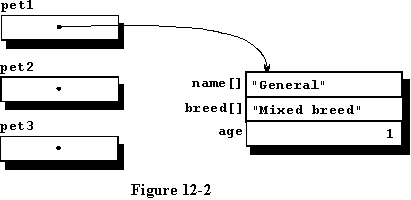 If
you remember our studies of structures and pointers, you will recall that
if we have a structure with a pointer pointing to it, we can access any
of the variables within the structure. In lines 20 through 22 of the program,
we assign some silly data to the structure for illustration. It should
come as no surprise to you that these assignment statements look just like
assignments to statically defined variables. Figure 12-2 illustrates the
state of the data space following execution of line 22.
If
you remember our studies of structures and pointers, you will recall that
if we have a structure with a pointer pointing to it, we can access any
of the variables within the structure. In lines 20 through 22 of the program,
we assign some silly data to the structure for illustration. It should
come as no surprise to you that these assignment statements look just like
assignments to statically defined variables. Figure 12-2 illustrates the
state of the data space following execution of line 22.
In line 24, we assign the value of pet1 to pet2 also via a pointer assignment statement which we introduced in chapter 8. This creates no new data, we simply have two pointers to the same object. Since pet2 is pointing to the structure we created above, pet1 can be reused to get another dynamically allocated structure which is just what we do next. Keep in mind that pet2 could have just as easily been used for the new allocation. The new structure is filled with silly data for illustration in lines 27 through 29.
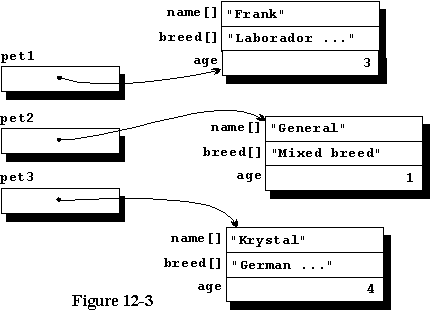
Finally, we allocate another block on the heap using the pointer pet3, and fill its block with illustrative data. Figure 12-3 illustrates the condition of the data space after execution of line 34 of the program.
Printing the data out should pose no problem to you since there is nothing new in the three print statements.
Even though it is not illustrated in this tutorial, you can dynamically allocate and use simple variables such as a single char type variable. This should be discouraged however since it is very inefficient.
GETTING RID OF THE DYNAMICALLY ALLOCATED DATA
Another new function is used to get rid of the data and free up the space on the heap for reuse, the function free(). To use it, you simply call it with the pointer to the dynamically allocated block of data as the only argument, and the block is deallocated.
In order to illustrate another aspect of the dynamic allocation and deallocation of data, an additional step is included in the program on your monitor. The pointer pet1 is assigned the value of pet3 in line 47. In doing this, the block that pet1 was pointing to is effectively lost since there is no pointer that is now pointing to that block. It can therefore never again be referred to, changed, or deallocated. That memory, which is a block on the heap, is wasted from this point on. This is not something that you would ever purposely do in a program. It is only done here for illustration.
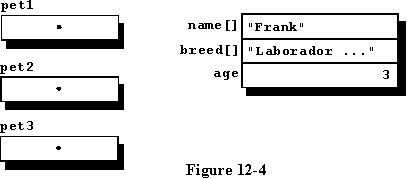 The
first free() function call removes the block of data that pet1
and pet3 were pointing to, which deallocates the structure and
returns the memory to the heap for further use. The second free()
call deallocates the block of data that pet2 was pointing to. We
therefore have lost access to all of our data generated earlier. There
is still one block of data that is on the heap but there is no pointer
to it since we lost the address to it. Figure 12-4 illustrates the data
space as it now appears. Trying to free the data pointed to by pet1
would result in an error because it has already been freed by the use
of pet3. There is no need to worry, however. When we return to the
operating system, the entire heap will be disposed of with no regard to
what we have put on it. The point does need to made that, if you lose a
pointer to a block of the heap, it forever removes that block of data storage
from our use and we may need that storage later.
The
first free() function call removes the block of data that pet1
and pet3 were pointing to, which deallocates the structure and
returns the memory to the heap for further use. The second free()
call deallocates the block of data that pet2 was pointing to. We
therefore have lost access to all of our data generated earlier. There
is still one block of data that is on the heap but there is no pointer
to it since we lost the address to it. Figure 12-4 illustrates the data
space as it now appears. Trying to free the data pointed to by pet1
would result in an error because it has already been freed by the use
of pet3. There is no need to worry, however. When we return to the
operating system, the entire heap will be disposed of with no regard to
what we have put on it. The point does need to made that, if you lose a
pointer to a block of the heap, it forever removes that block of data storage
from our use and we may need that storage later.
Compile and run the program to see if it does what you think it should do based on this discussion.
THAT WAS A LOT OF DISCUSSION
It took several pages to get through the discussion of the last program but it was time well spent. It should be somewhat exciting to you to know that there is nothing else to learn about dynamic allocation, the previous discussion covered it all. Of course, there is a lot to learn about the technique of using dynamic allocation, and for that reason, there are two more example programs to study.
AN ARRAY OF POINTERS
Example program ------> BIGDYNL.C
Load and display the file BIGDYNL.C for another example of dynamic allocation. This program is very similar to the last one since we use the same structure, but this time we define an array of pointers to illustrate the means by which you could build a large database using an array of pointers rather than a single pointer to each element. To keep it simple we define 12 elements in the array and another working pointer named point.
The *pet[12] is new to you so a few words would be in order. What we have defined is an array of 12 pointers, the first being pet[0], and the last pet[11]. Actually, since an array is itself a pointer, the name pet by itself is a constant pointer to a pointer. This is valid in C, and in fact you can go farther if needed but you will get quickly confused. There is no limit as to how many levels of pointing are possible, so the definition int ****pt; is legal as a pointer to a pointer to a pointer to a pointer to an integer type variable, if I counted right. Such usage is discouraged until you gain considerable experience.
Now that we have 12 pointers which can be used like any other pointer, it is a simple matter to write a loop to allocate a data block dynamically for each and to fill the respective fields with any data desirable. In this case, the fields are filled with simple data for illustrative purposes, but we could be reading from a database, from some test equipment, or from any other source of data.
You will note that this time we carefully check the return value from the malloc() function to see that it contains a non-zero value. If it returns a NULL value, we print a message that the allocation failed and exit the program. In a real production program, you would not simply terminate the program. It would be much more agreeable with the user to report the error to him and give him the opportunity to make more memory available before actually terminating the program. Error handling and recovery is a topic you will need to study someday, but it is beyond the scope of your programming experience at this point.
A few fields are randomly picked in lines 33 through 35 to receive other data to illustrate that simple assignments can be used, and the data is printed out to the monitor. The pointer point is used in the printout loop only to serve as an illustration. The data could have been easily printed using the pet[n] means of definition. Finally, all 12 blocks of data are freed before terminating the program.
Compile and run this program to aid in understanding this technique. There was nothing new here about dynamic allocation, only about an array of pointers.
A LINKED LIST
Example program ------> DYNLINK.C
We finally come to the granddaddy of all programming techniques as far as being intimidating. Load the program DYNLINK.C for an example of a dynamically allocated linked list. It sounds terrible, but after a little time spent with it, you will see that it is simply another programming technique made up of simple components that can be a powerful tool.
In order to set your mind at ease, consider the linked list you used when you were a child. Your sister gave you your birthday present, and when you opened it, you found a note that said, "Look in the hall closet." You went to the hall closet, and found another note that said, "Look behind the TV set." Behind the TV you found another note that said, "Look under the coffee pot." You continued this search, and finally you found your pair of socks under the dogs feeding dish. What you actually did was to execute a linked list, the starting point being the wrapped present and the ending point being under the dogs feeding dish. The list ended at the dogs feeding dish since there were no more notes.
In the program DYNLINK.C, we will be doing the same thing your sister forced you to do. However, we will do it much faster and we will leave a little pile of data at each of the intermediate points along the way. We will also have the capability to return to the beginning and traverse the entire list again and again if we so desire.
THE DATA DEFINITIONS
This program starts similarly to the last two with the addition of a constant declaration to be used later. The structure is nearly the same as that used in the last two programs except for the addition of another field within the structure in line 13, the pointer. This pointer is a pointer to another structure of this same type and will be used to point to the next structure in order. To continue the above analogy, this pointer will point to the next note, which in turn will contain a pointer to the next note after that.
We define three pointers to this structure for use in the program, and one integer to be used as a counter, and we are ready to begin using the defined structure for whatever purpose we desire. In this case, we will once again generate nonsense data for illustrative purposes.
THE FIRST FIELD
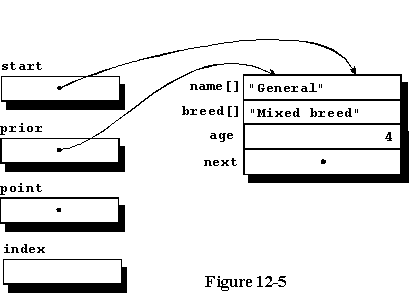 Using
the malloc() function, we request a block of storage on the heap
and fill it with data being careful to check the return to assure that
we did get a good allocation. The additional field in this example, the
pointer, is assigned the value of NULL, which is used to indicate that
this is the end of the list. We will leave the pointer named start pointing
at this structure, so that it will always point to the first structure
of the list. We also assign prior the value of start for
reasons we will see soon. Keep in mind that the end points of a linked
list will always have to be handled differently than those in the middle
of a list. We have a single element of our list now and it is filled with
representative data. Figure 12-5 is the graphical representation of the
data space following execution of line 33.
Using
the malloc() function, we request a block of storage on the heap
and fill it with data being careful to check the return to assure that
we did get a good allocation. The additional field in this example, the
pointer, is assigned the value of NULL, which is used to indicate that
this is the end of the list. We will leave the pointer named start pointing
at this structure, so that it will always point to the first structure
of the list. We also assign prior the value of start for
reasons we will see soon. Keep in mind that the end points of a linked
list will always have to be handled differently than those in the middle
of a list. We have a single element of our list now and it is filled with
representative data. Figure 12-5 is the graphical representation of the
data space following execution of line 33.
FILLING ADDITIONAL STRUCTURES
The next group of assignments and control statements are included within a for loop so we can build our list fast once it is defined. We will go through the loop a number of times equal to the constant RECORDS defined at the beginning of the program. Each time we go through the loop, we allocate memory, test the allocation return, fill the first three fields with nonsense, and fill the pointers. The pointer in the last record is given the address of this new record because the prior pointer is pointing to the prior record. Thus prior->next is given the address of the new record we have just filled. The pointer in the new record is assigned the value NULL, and the pointer prior is given the address of this new record because the next time we create a record, this one will be the prior one at that time. That may sound confusing but it really does make sense if you spend some time studying it.
Figure 12-6 illustrates the data space following execution of the loop two times. The list is growing downward by one element each time we execute the statements in the loop. When we have gone through the for loop 6 times, we will have a list of 7 structures including the one we generated prior to the loop. The list will have the following characteristics.
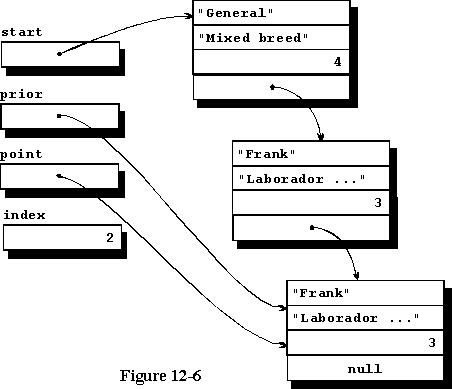
It should be clear to you, if you understand the overall data structure, that it is not possible to simply jump into the middle of the list and change a few values. The only way to get to the third structure is by starting at the beginning and working your way down through the list one record at a time. Although this may seem like a large price to pay for the convenience of putting so much data outside of the program area, it is actually a very good way to store some kinds of data.
A word processor would be a good application for this type of data structure because you would never need to have random access to the data. In actual practice, this is the basic type of storage used for the text in a word processor with one line of text per record. Actually, a program with any degree of sophistication would use a doubly linked list. This would be a list with two pointers per record, one pointing down to the next record, and the other pointing up to the record just prior to the one in question. Using this kind of a record structure would allow traversing the data in either direction.
PRINTING THE DATA OUT
To print the data out, a similar method is used as that used to generate the data. The pointers are initialized and are then used to go from record to record, reading and displaying each record one at a time. Printing is terminated when the NULL in the last record is found, so the program doesn't even need to know how many records are in the list. Finally, the entire list is deleted to make room in memory for any additional data that may be needed, in this case, none. Care must be taken to assure that the last record is not deleted before the NULL is checked. Once the data is gone, it is impossible to know if you are finished yet.
MORE ABOUT DYNAMIC ALLOCATION AND LINKED LISTS
It is not difficult, nor is it trivial, to add elements into the middle of a linked list. It is necessary to create the new record, fill it with data, and point its pointer to the record it is desired to precede. If the new record is to be installed between the 3rd and 4th, for example, it is necessary for the new record to point to the 4th record, and the pointer in the 3rd record must point to the new one. Adding a new record to the beginning or end of a list are each special cases. Consider what must be done to add a new record in a doubly linked list.
Entire books are written describing different types of linked lists and how to use them, so no further detail will be given. The amount of detail given should be sufficient for a beginning understanding of C and its capabilities.
TWO MORE FUNCTIONS
Two additional functions must be mentioned, the calloc() and the realloc() functions. The calloc() function allocates a block of memory and clears it to all zeros which may be useful in some circumstances. It is similar to malloc() and will be left as an exercise for you to read about and use calloc() if you desire. Generally, you allocate a block of memory and immediately fill it with meaningful data so it wastes time to fill it with zeros in the calloc(), then fill it with real data. For this reason, the calloc() function is rarely used.
The realloc() is used to change the size of an allocated block, either bigger or smaller. You should ignore this until you gain a lot of experience with C. It is rarely used, even by experienced programmers.
PROGRAMMING EXERCISES